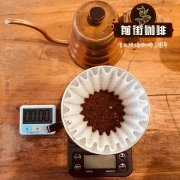Flavor characteristics of Brazilian Santos Coffee washing Brazilian Santos caffeic acid? how does it taste?

Professional coffee knowledge exchange more coffee bean information please follow the coffee workshop (Wechat official account cafe_style)
Brazilian Santos coffee beans
Brazil Santos Washed
Continent: South America
Coffee bean seed: BOURBON
Treatment: washing
Level: NO.2
Brazilian Santos flavor features: a small number of Santos washed coffee, low acidity, chocolate bitterness and nutty flavor, high mellow thickness, balanced taste, is a typical representative of Brazilian flavor. The aroma is elegant, sour and soft, delicious and fragrant.
Bitterness ★★★ acidity ★★ back glycol ★★★ alcohol ★★★
Santos, Brazil: low acidity, moderately roasted coffee beans from the World Coffee Center.
Brazil is vividly compared to the "giant" and "monarch" of the coffee world. There are about 3.97 billion coffee trees there, and small farmers now grow 75% of Brazil's total coffee production. The number of coffee producers in Brazil is twice or even three times that of Colombia, the second largest coffee producer in the world.
Unlike in the past, Brazil's economy is now less dependent on coffee, with Brazilian Santos coffee accounting for only 8% to 10% of GDP. Before World War II, Brazil accounted for 50% or more of the world's coffee production, and now it is close to 30%. But the country's impact on the world's coffee, especially on coffee prices, is significant. For example, two frost disasters in 1994 caused a sharp rise in global coffee prices.
Since the introduction of coffee trees from French Guiana (Guyana) in 1720, coffee production has gradually become a science. Before 1990, the Brazilian government carried out strict monitoring of the coffee industry, with both strict intervention and price protection measures, and the state has been implementing minimum price protection measures for farmers, resulting in coffee overproduction. Before World War II, the remaining stock reached 78 million bags, which had to be burned by fire or thrown into the water to destroy.
Since the opening of the free market in 1990, the original Brazilian Coffee Authority (IBC) has been replaced by the National Economic Association, the country's non-investment administrative body, which pursues a policy of non-intervention and allows producers to negotiate directly with exporters. The business activities of exporters are supervised by the government legislation, and the relevant departments register legitimate exporters.
Important Notice :
前街咖啡 FrontStreet Coffee has moved to new addredd:
FrontStreet Coffee Address: 315,Donghua East Road,GuangZhou
Tel:020 38364473
- Prev

Brazilian Santos Coffee Variety characteristics Flavor characteristics Brazilian Santos caffeic acid
Professional coffee knowledge exchange more coffee bean information Please follow the coffee workshop (Wechat official account cafe_style) varieties come from South America Brazil is the world's number one coffee producer, accounting for about 30% of the world's total production. Almost all Brazilian Santos coffee is produced in southeastern Brazil and is the best of Brazilian coffee. Raw bean granules can be found from medium to large, but without green, belonging to medium
- Next

Harald Coffee Bean Flavor and Taste A brief introduction to the Historical production and processing of Essex Harald Coffee Story
Professional coffee knowledge exchange more coffee bean information please follow the coffee workshop (Wechat official account cafe_style) after the selection of Harald coffee raw beans, with a faint floral flavor. Harald Coffee is located in the Hara (Harald) Mountains in eastern Ethiopia, because it maintains the most traditional sun treatment, making the coffee beans as rich as red wine.
Related
- Detailed explanation of Jadeite planting Land in Panamanian Jadeite Manor introduction to the grading system of Jadeite competitive bidding, Red bid, Green bid and Rose Summer
- Story of Coffee planting in Brenka region of Costa Rica Stonehenge Manor anaerobic heavy honey treatment of flavor mouth
- What's on the barrel of Blue Mountain Coffee beans?
- Can American coffee also pull flowers? How to use hot American style to pull out a good-looking pattern?
- Can you make a cold extract with coffee beans? What is the right proportion for cold-extracted coffee formula?
- Indonesian PWN Gold Mandrine Coffee Origin Features Flavor How to Chong? Mandolin coffee is American.
- A brief introduction to the flavor characteristics of Brazilian yellow bourbon coffee beans
- What is the effect of different water quality on the flavor of cold-extracted coffee? What kind of water is best for brewing coffee?
- Why do you think of Rose Summer whenever you mention Panamanian coffee?
- Introduction to the characteristics of authentic blue mountain coffee bean producing areas? What is the CIB Coffee Authority in Jamaica?

